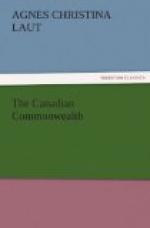Instead of that repose which marks the maritime provinces, one finds an eager fronting to the future that is almost feverish. If Panama is turning the entire Pacific into a front door instead of a back door, then British Columbia knows the coign of vantage, which she holds as an outlet for half Canada’s commerce by way of the Pacific. It is in British Columbia that East must meet West and work out destiny.
[1] In 1800, the United States population was 5,308,483; in 1901, the Canadian population was 5,371,315.
[2] Ireland lost one-half her population from 1840 to 1900, Her population dropped in round numbers from eight millions to four millions.
[3] Total foreign trade of Canada, 1912, $1,085,264,000; of United States, $4,538,702,000.
[4] This presupposes immigration to the United States at a million and a quarter, as before the war.
[5] Speaking generally, there are few sections of the Northwest where the average rainfall is scanty.
[6] The areas of all the Canadian provinces except the maritime ones have been extended in recent years—Quebec to include Labrador—except the East Shore, which is under Newfoundland; Ontario to James Bay; Manitoba and Saskatchewan to Hudson Bay; Alberta to MacKenzie River. Northern British Columbia is not yet surveyed, which explains why its northern area is largely a matter of guess—closest estimates placing the whole province including Yukon as twice Germany; without Yukon as about one and two-thirds the area of Germany; but this is rough guesswork.
[7] Canada’s fisheries for 1912 yielded $34,667,872.
[8] Canada’s subsidies to steamships vary from year to year, but I do not think any year has much exceeded two millions.
[9] This is including Labrador.
[10] Under crop in Manitoba, Saskatchewan and Alberta 16,478,000 acres. Area surveyed available for cultivation 158,516,427 acres; land area, 466,068,798 acres.
[11] The rate from the head of the Lakes to Montreal is usually four to five cents. It has been as low as one cent, when grain was carried almost for ballast.
[12] British Columbia’s population in 1912 was 392,480.
[13] Canada, mineral production for 1911 stands thus: copper, $6,911,831: gold, $9,672,096; iron, $700,216; lead, $818,672; nickel, $10,229,623; silver, $17,452,128; other metal, $322,862; total, $46,197,428. Non-metallic production 1911: coal $26,378,477; cement, $7,571,299; clay, $8,317,709; stone, $3,680,361; in all, $56,094.258.
CHAPTER III
THE TIE THAT BINDS




